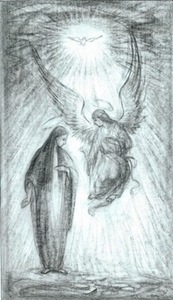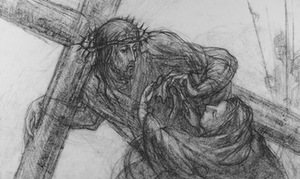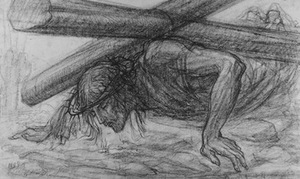EXHIBITION 'SACRED SKETCHES' BY V. KAŠINSKAS - FOR PEOPLE INTERESTED IN RELIGIOUS ART 3
In brief: The title of the exhibition ‘Sacred Sketches’ by artist Virginijus Kašinskas suggests at once that it is designed for certain public – people who are interested in religious art. The sketches, that gave a start for the pictures of altar and Stations of the Cross at Kaunas St. Archangel Church and St. Virgin Mary Visitation (Pažaislis) Church, are shown in the display.
V. Kašinskas is more known as the author of ‘ethno-painting’ and picture series on Lithuanian mythology, such as ‘Cosmogony’, ‘Mythological Stones’ or ‘Gates of Earth’. In the meantime, works of the new exhibition are based on the Christian iconography and archetypical symbolism. Rational and irrational elements are combined and interpreted by the artist in the peculiar way. Layers of developed stylisations, compositions and colours are revealed here. Drawings look rather expressive; objects are shaped by brave, firm lines and the principle of contrast.
According to the author, a sketch is a transitional work for him, reflecting one of the classical phases of creating painting. The primary idea, subject of the picture and composition are located in a sketch. Later the colour etude is created. Finally the original is painted, which becomes an organic part of liturgical rituals at church.
The artist accentuates that a good, professional sketch is valuable as well as a completed picture. This idea is not new. The 18th c. art critic and philosopher Denis Diderot was one of the first to consider sketches as full-rate works of art. In his words, there is more spontaneity in sketches than in works of art. A viewer observing a drawing is able to imagine the process of creation and empathise with it. It is kind of a pulsating beginning and the end of something.
Usually the exhibitions of sketches are organised in Lithuania rather rarely. The international exhibition ‘Sketch 2010’ was organised in Šiauliai last year. The show aimed to revive the classical tradition of a sketch and examined its issues as a work of art. The famous German painter Rainer G. Mordmüller, who participated in the exhibition, called a sketch the reason for the birth of an idea. In his words, ‘the first sketch is the baseline for other sketches and variations on the same subject. A sketch is characteristic of openness. It shows the beginning of a picture, determines its direction and position. A sketch is the possibility that can change till the last brushstroke’.
V. Kašinskas‘s work is related to certain ideals, the superior and fundamental values that give the single-mindedness for the artist. He aims to highlight the basic elements of physical and spiritual life and to create structures, conveying the harmony of the both spheres but the content is the most important issue in his religious works.
An artist-atheist should not go into religious topics because it is necessary to know the Bible well in order to work in this field. An artist who creates for the church has to know the credenda so he can approach a chosen subject and depict the idea properly. Nowadays the spheres of the profane and religious sacrality are approaching each other and the profanity most often wins. The reason for that, in the author‘s words, is atheism, seeded in the Soviet period. ‘The sacred art goes underground gradually, by yielding ground to the postmodern art. Sacred art delimits significant things from the accessible, elementary ones that fit into the concept of profanity’, - he says.
Overall, this exhibition of sacred sketches revealed a new outlook at the possibilities of treating them as works of art. Such artworks are able to create new meanings and to remind of the forgotten cultural traditions. The show also raised the problem of the position that sacred art takes in the contemporary context and gave the possibility to contemplate it.



